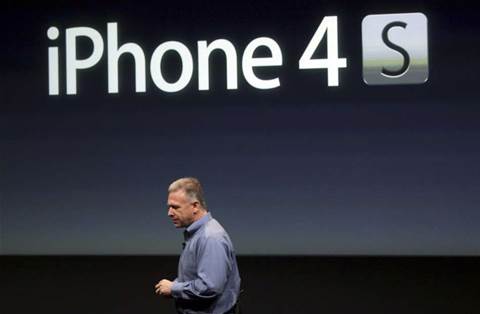The apparent lack of near-field communications (NFC) capabilities in Apple’s iPhone 4S announced this week could delay banks’ plans for “end-game” contactless mobile payment applications.
Australian banks, mobile operators and analysts had speculated that an iPhone 5 with embedded NFC capabilities would spark the development and uptake of mobile wallets.
But Apple made no mention of an iPhone 5 or NFC when it unveiled its fifth-generation smartphone, the iPhone 4S, on Tuesday night.
Rod Farmer of user experience consultancy Mobile Experience said the announcement could delay rapid large-scale consumer adoption of NFC payment technology.
“It will slow it down, because you lose a lot of the use case,” he said, highlighting the millions of Apple customers that might otherwise have been able to seamlessly make NFC payments from their iTunes accounts.
“What Apple does very well is vertical integration [of hardware, software and services],” he said. “There’s no one out there who can really do that alone besides Apple and potentially Google.”
Few NFC-enabled smartphones have reached the Australian market besides Google’s Nexus S, which was introduced by Vodafone earlier this year.
The Google Wallet application, launched last month, allowed US-based Nexus S users to make NFC payments. No such application was available in Australia.
In the absence of mainstream, NFC-enabled smartphones, Australian banks have relied on NFC phone cases or stickers to develop applications and trial the technology.
Earlier this year, Westpac kicked off an internal trial for which 50 users put microchipped stickers on the backs of their phones.
Users could then swipe their smartphones across Visa or MasterCard contactless terminals to make low-value payments in the same way as they would with contactless credit cards.
Westpac’s head of merchant acquiring, George Lawson – who was one of the users in the trial – said it went “very well”.
Commercial trials could begin as early as next year, he said.
“Are we looking at trying to roll that out more broadly? We’re still working through whether that’s the case or not,” he told iTnews at an AIIA event last week.
“I think we learned a lot about [NFC]. I was actually using it myself and found that I started to forget to take my wallet to places; I was surprised at how quickly that happened to me.”
Lawson said the trial application was not an “end-game solution” but a “bridging solution” that functioned like Visa’s payWave or MasterCard’s PayPass contactless cards.
PayPal Australia’s managing director Frerk-Malte Feller speculated last month that the experience of paying by contactless card was too similar to regular cards to be attractive.
The “secret sauce” of innovation, he said, was to identify and address pain points like queueing or having to collect and store paper receipts with customers’ signatures.
The value-add battleground
Rohan Ganeson, managing director of Optus’ small and medium business group, expected the adoption of NFC-enabled handsets to be driven by applications other than payments – including loyalty and coupon services.
He expected the provision of value-added services to be an area of contention as shrinking margins forced both banks and telcos out of their traditional areas of payments and carriage.
“If you speak to any telco, they don’t believe their world today is carriage. I think that margins are fundamentally eroding,” he said.
“One of the challenges we have is we think we will all form part of a value chain where we will all play together.
“For us, it’s about moving up the value chain, and that will inevitably cause a bump on the road for another player, and that’s a challenge.”
Ganeson said it was “too early to tell” where the boundaries between NFC collaborators would lie and whether or not Optus would have to face financial services regulator APRA in due course.
He highlighted Optus’ Digital Life portfolio of content, TV and coupon services as an example of value-added services to which mobile payments would add a “key element”.
For Westpac, the end-game NFC solution would involve a smartphone application that integrated similar value-add functions with remote and NFC payments.
Westpac’s Lawson and Mobile Experience’s Farmer agreed that this was not possible without NFC-embedded smartphones.
Commercial availability
Lance Blockley of financial services consultancy Edgar, Dunn and Company did not expect any far-reaching commercial rollouts of NFC payment technology in the next 18 months.
Smaller pilots and tests would continue, he said, highlighting upcoming NFC-enabled handsets from manufacturers including Samsung and Nokia.
“Early adoptors of proximity payment services will have access to NFC-enabled phones, albeit not an iPhone,” he said.
“We do not believe that the lack of NFC functionality in the iPhone 4S will significantly impact the progression toward NFC payments in Australia.”
Blockley said “early commercial availability” of NFC-related payment services would likely occur by late next year.
“If Apple wants to participate in mobile proximity payments, we would expect them to support NFC in their next release [of the iPhone],” he said.
“Given Apple’s typical release cycles – new models every eight to 12 months – they should be well-positioned to jump into NFC payments at that point.
“If, however, they omit NFC from their offering at that time, then it might slow broader consumer adoption of NFC for payments.”
Earlier this year, Blockley speculated that Australia lacked the scale and “burning need” to support a business case for NFC and banks and telcos were refusing to fully cooperate.
Westpac’s Lawson said the bank would look at proof-of-concepts while it waited “for some key pieces to fall into place”.
The key, he said, was ubiquity.
“If we’re going to be stuck with a particular carrier on a particular phone, then I’m segmenting my customer base down to such a small extent that it’s not going to be something that I can offer more broadly to my customers,” he said.
“It comes down to the collaboration piece; we’re still trying to talk to the telcos and schemes [such as Visa and MasterCard] about what their end-game operating model will look like.”








_(11).jpg&h=142&w=230&c=1&s=1)



.jpg&w=100&c=1&s=0)
_(8).jpg&w=100&c=1&s=0)









